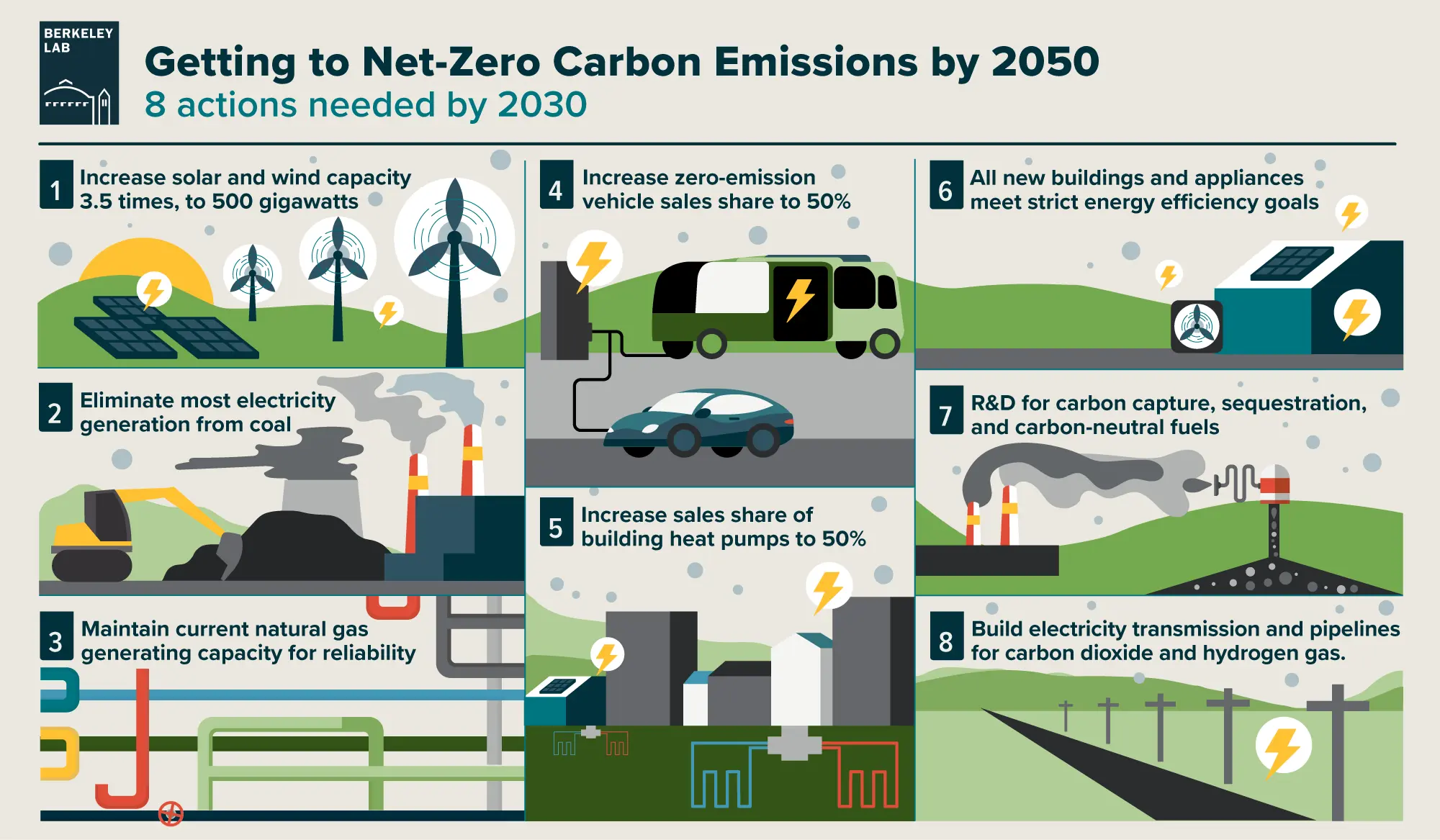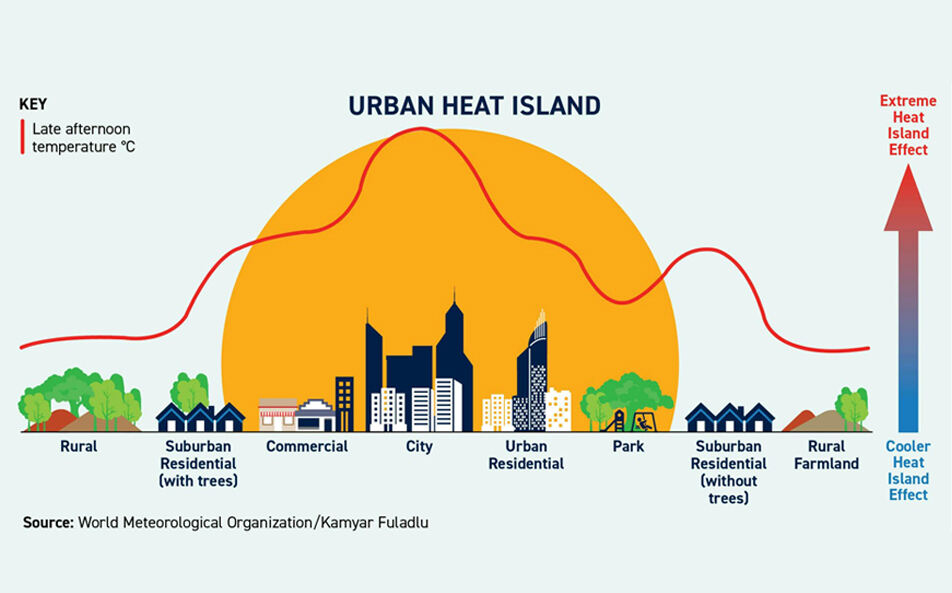
The United Indian

One of the biggest issues of our time is climate change. To defeat it, the world strives to reach net-zero carbon emissions by 2050. That is, equate the volume of greenhouse gases emitted with the volume taken out of the air. Technology plays a significant part here.
Understanding Net-Zero Carbon Emissions
The term net-zero carbon emissions means that the amount of carbon dioxide (CO₂) emissions is decreased to the maximum extent possible, and the remaining emissions are balanced using methods such as carbon capture or reforestation. The purpose is to make sure that the amount of CO₂ released into the atmosphere is the same as the amount that is withdrawn.
Technology´s role in reaching net zero
It is not feasible to achieve net-zero without the help of technological innovations. Renewable energy, carbon capture, among other technologies not only play a significant role in reducing emissions in different sectors but also might be the most viable solution.
Key Technologies Driving Net-Zero Goals
- Renewable Energy - The transition from fossil fuels to renewable energy is essential. Equipment such as solar panels and wind turbines produces electricity without releasing CO₂. Renovation is imperative to the International Energy Agency (IEA) for the removal of emissions.
- Energy Efficiency - Improving the energy efficiency of something means decreasing power usage for various tasks. This can come from different areas, such as being able to insulate buildings softly, while appliances and industrial systems operate in an energy-efficient manner. The least waste of energy is one of the focuses of the IEA, which is designed for the emission reduction process.
- Carbon Capture, Utilization, and Storage (CCUS) - The finding of CCUS technologies shows that power plants and industrial plants are the major emitters of CO₂. The recovered CO₂ from the sources of emissions can be stored under the earth or can also be used in other ways. The International Energy Agency (IEA) suggests that the most effective way of reducing emissions in those sectors where the emissions are nearly impossible to eradicate is through the application of CCUS technology.
- Hydrogen Fuel -Hydrogen is envisioned as being the agent that can carry the energy everywhere in a clean manner. When the process of hydrogen creation has at its source green energy, then there is no CO₂ produced. One of the applications that is very beneficial is the transportation and industrial field. In its latest report, the IEA claims that hydrogen and hydrogen-based fuels make a lot of sense in terms of CO₂ reduction.
- Digital Technologies and Artificial Intelligence (AI) - Digital tools and AI are used in the energy sector to manage resources, predict maintenance, and improve the efficiency of the system. The Royal Society, therefore, is suggesting that digital technology can make up for almost a third of the carbon emission reductions to be effected by 2030.
Real-World Examples
Apple's Carbon Reduction Efforts
Apple announced a significant drop in its carbon footprint as the company managed to achieve a 5% cut in climate pollution in 2024 compared to 2023, representing 800,000 metric tons. While the AI boom had industry-wide emissions on the rise, Apple had the success of topping the worldwide greenhouse gas emission reduction by more than 60% in the last decade. A lot of this result can be attributed to the company's clean energy, eco-friendly product design, and involvement of suppliers in green efforts.
Singapore's Ocean Carbon Removal Facility
The ocean carbon dioxide removal project that is under construction in Singapore is planned to be, indeed, the world's biggest, and it is going to draw out 3,650 metric tons of CO₂ per year. This initiative is a win-win source of resupply to the ocean carbon sequestration effect and is Singapore's effort to achieve net-zero greenhouse gas emissions by 2050.
Top Issues Left
Technology may resolve one set of problems, yet the challenges remain:
- Cost: New technology can be costly to install.
- Existing Systems: The upgrade of old systems that can comply with the new technology will be a big expense.
- Law and Regulations: The policies that back the technological advance are critical.
Role of the Private Sector in Net-Zero Innovations
The private sector has a massive role in making zero carbon emission goals possible. Presently, all businesses across industries are channelling their investments into cleaner technologies and low-carbon alternatives.
Most of our key industries, such as Tesla, Toyota, and BMW, are launching electric cars (EVs), which are zero-tailpipe emission vehicles. EVs are a significant tool for carbon reduction. Additionally, it is projected by the IEA that EVs would make up to 1.5 gigatonnes of CO₂ emission reductions each year by the year 2040, in the case of their mass adoption.
It is not only automaker firms that are confronting the green challenge with hydrogen, SAF, and the circular economy. Firms like Google and Microsoft are using carbon removal techniques by 2030, in part through artificial intelligence for energy efficiency and renewable energy production in data centers.
They are collaborating with machine learning to develop an efficient data center and the users of clean energy. So the circular manufacturing practice, a process that is getting materials recycled and waste reduced, is being utilized in the green aviation method, apart from the green hydrogen and SAF industry.
Government Support and Global Agreements
World governments all over the world are promoting your Net Zero Carbon Emissions journey through policies and financial support for green projects. They help with the transition to low CO2 emission in many ways, these include initiatives, policies, and support in low carbon infrastructures...
The example of the European Green Deal is exactly one of the above methods, and its purpose is to make Europe carbon-free by 2050. The plan also includes an investment of $1 trillion and regulations (laws) to cut emissions by at least 55% by 2030. On the other hand, in the U.S., the Inflation Reduction Act of 2022 was praised by the Environmental Protection Agency (EPA), with a budget of over $369 billion.
The same period necessitates close cooperation among nations of the world. The establishment of a collective goal for reducing emissions in the Paris Climate Agreement is a case in point. As a result of the adoption of the Paris Climate Accord, more than 190 countries have jointly agreed to restrict global warming from exceeding 2°C above pre-industrial level and to strive to reach...
Such alliances bring about a consumption of clean technologies on a large scale and the design of cities and towns with consideration for the climate.
The Path Forward
It is indeed a daunting mission to reach carbon neutrality, and it calls for action on different levels, such as global cooperation, investment, and innovation. Because we master technology today, we can push the boat forward concerning owing to a responsible and respectful future that is sustainable for the coming generations.
Frequently Asked Questions (FAQ's)
Q1. What does "net-zero emissions" actually mean?
Net-zero emissions means achieving a balance between the greenhouse gases released into the atmosphere and those removed from it. This balance is essential for stabilizing global temperatures and mitigating climate change impacts.
Q2. Which technologies show the most promise for reducing carbon emissions quickly?
Renewable energy technologies (solar and wind) and electrification of transportation are showing the fastest progress due to rapidly falling costs and increasing efficiency. These technologies are already economically competitive with fossil fuel alternatives in many markets.
Q3. Is carbon capture technology effective enough to make a difference?
Carbon capture technologies are still evolving but are considered essential for achieving net-zero goals. While currently expensive ($50-600 per ton of CO2 depending on the method), they're expected to become more cost-effective as they scale up and improve through continued innovation.
Q4. How can digital technologies help reduce emissions?
Digital technologies like smart grids, IoT devices, and AI optimize energy use, enable higher renewable energy integration, improve efficiency across systems, and provide critical data for decision-making. For example, AI has helped reduce cooling energy in data centers by up to 40%.
Q5. Is reaching net-zero emissions by 2050 technologically possible?
Yes, it's technologically possible, but challenging. Most of the technologies needed already exist, though some require further development. The main challenges involve scaling these technologies quickly enough, securing necessary investments (estimated at $4 trillion annually by 2030), and implementing supportive policies.
Read more in Environment
May 27, 2025
TUI Staff
May 27, 2025
TUI Staff

Stay Tuned with The United Indian!
Our news blog is dedicated to sharing valuable and pertinent content for Indian citizens. Our blog news covering a wide range of categories including technology, environment, government & economy ensures that you stay informed about the topics that matter most. Follow The United Indian to never miss out on the latest trending news in India.
©The United Indian 2024










